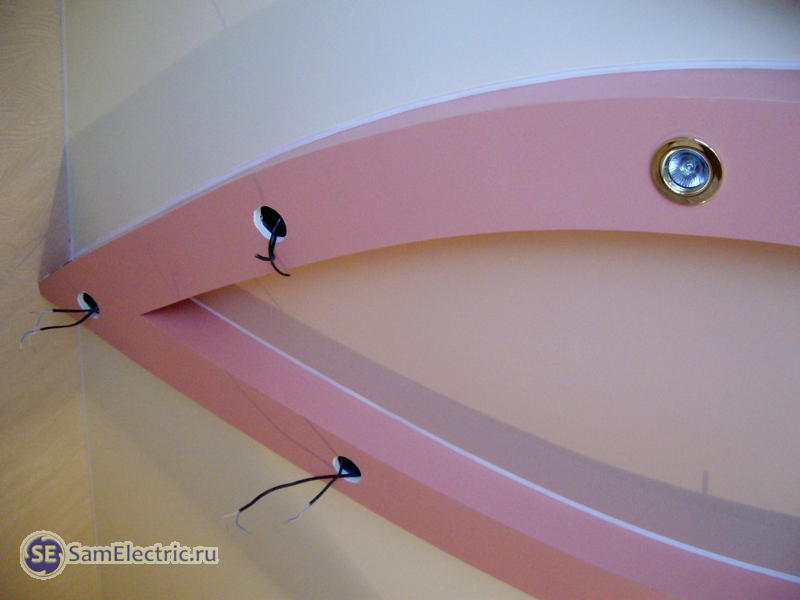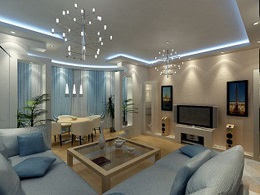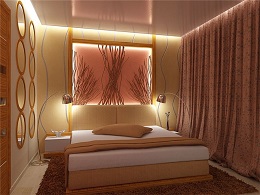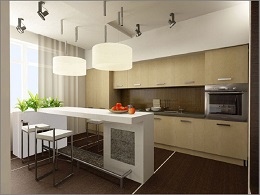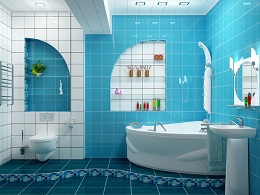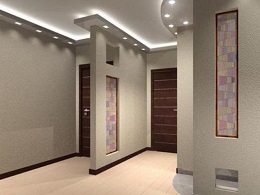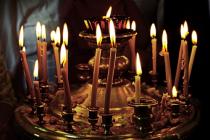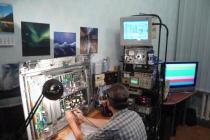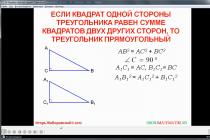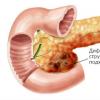Any room will look unfinished and uncomfortable if not done beautiful ceiling. Modern ceiling designs allow to realize any ideas of designers. One of the most popular types of finishes today are stretch ceilings. They have many advantages, including an excellent appearance.
Stretch ceilings allow you to use different types of lighting and even combine them with each other. In addition to the usual hook chandeliers, other types of lamps, including spotlights, can be installed on ceiling structures (read also: ""). However, not all lighting fixtures are suitable for stretch ceilings. Particular attention should be paid to light bulbs. You can install only low-power bulbs in a stretch ceiling so that there is no overheating of the canvas.
Since spotlights are most often installed on such structures, you should understand their types and features of use. There are currently four types spotlights. They can work with incandescent, halogen, energy-saving and. What do they look like different kinds bulbs, you can see in the photo.
Incandescent lamps
Luminaires that use incandescent lamps are inexpensive and easy to replace. Often used lamp minion, mirror E-14. Its power is 40-60 watts. In order to achieve average illumination, there should be one light bulb for every 2-3 "square" of the surface. If necessary, such bulbs for a stretch ceiling can be easily changed.
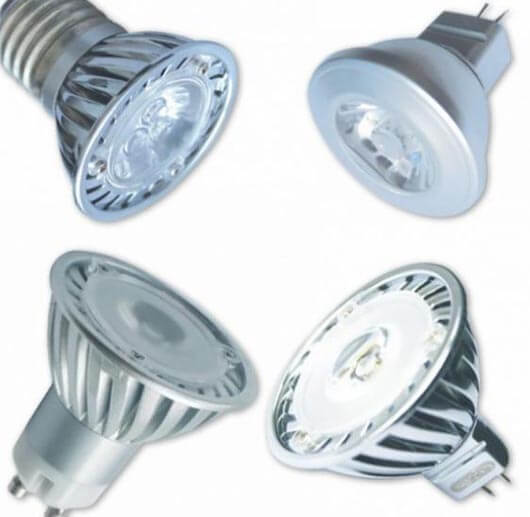
The benefits of incandescent lamps include:
- low price compared to other types;
- easy replacement - you can unscrew them and put a new one.
The disadvantages of incandescent lamps are:
- power restrictions - no more than 40 W (in some cases - 60 W), but if you install a more powerful lamp, the canvas may be deformed due to overheating;
- the fittings have considerable dimensions, so you will have to allocate 8-10 centimeters to lower the stretch ceiling.
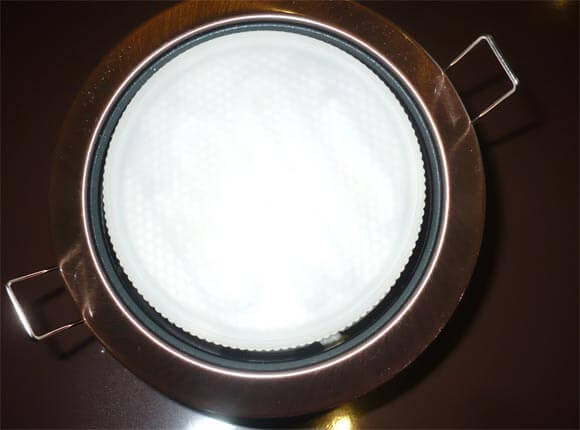
The main reason for choosing them is their low cost.
Halogen lamps
Halogen lamps are an excellent choice for stretch ceilings. They have many advantages over other types. The long service life of the bulbs favorably distinguishes them from other types of lamps for stretch ceilings. This is especially noticeable when comparing halogen lamps with incandescent lamps.
Advantages of halogen lamps:
- excellent illumination of the ceiling structure (due to their own rich glow, halogen built-in bulbs in the stretch ceiling are able to create colorful effects);
- the ability to arrange the backlight at any desired angle;
- a wide selection of colors and shapes of lamps;
- maximum brightness of lighting immediately after turning on the fixtures;
- long service life.
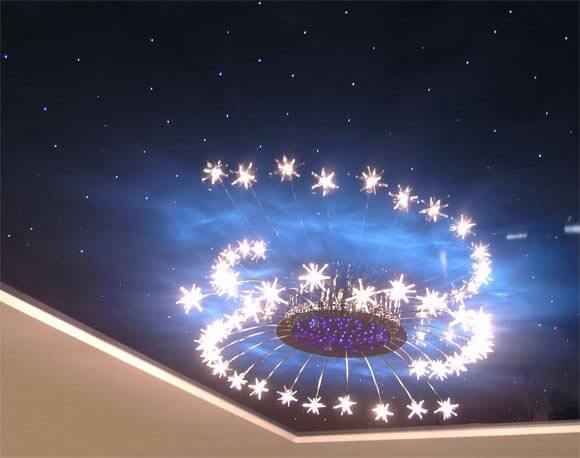
The disadvantages of halogen lamps include:
- directional glow;
- the emission of light of one type - warm yellow;
- lowering the ceiling by at least 7 centimeters (in rooms with a low height, install halogen lamps Not recommended).
Energy-saving lamps
Energy-saving light bulbs are very popular. Their main advantage is low heat generation, which allows you not to worry about overheating of the stretch ceiling. They are also very economical - their energy consumption is minimal.
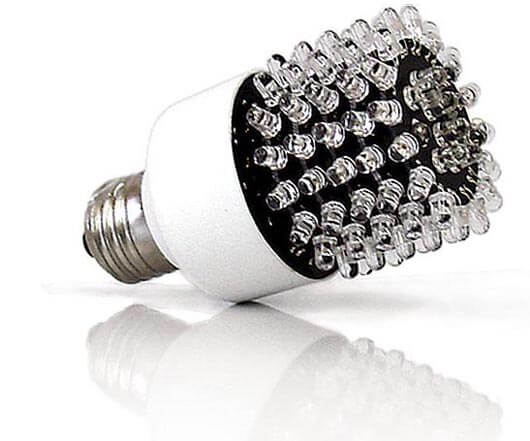
Energy-saving light bulbs for stretch ceilings have the following advantages:
- compliance with European standards;
- insignificant heat release, which makes it impossible to overheat the web (for comparison, incandescent lamps emit it several times more);
- economical consumption of electricity;
- lack of illumination behind the ceiling (other types of lamps have this effect);
- there is no need to reduce the height of the structure, since the size of the fixtures is only 2 centimeters. But this height is still necessary to install the canvas itself, since the baguette attached to the wall and necessary for mounting the ceiling has a size of 2.7 centimeters.
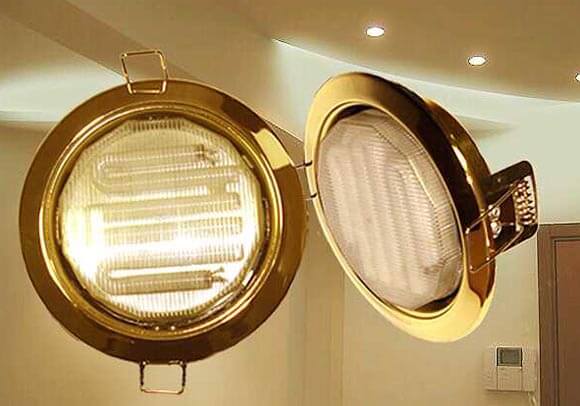
The disadvantages of energy-saving lamps include:
- lack of choice;
- high price;
- do not turn on at full power immediately - this will take time;
- simple appearance and only a few border color options.
When using energy-saving lamps, it must be borne in mind that the switch should not have an LED. Otherwise, you can observe the flickering of the bulbs when they are in the off state. Quite often it is believed that this effect occurs due to the lack of grounding or phase breakdown to zero, but these judgments are incorrect. The reason for this phenomenon is that the switch has an LED.
LED lamp
Experts recommend installing LED bulbs in a stretch ceiling in those rooms that cannot boast of a large area. They look good in the interior of any room, kitchen or bathroom. Their popularity is explained by their numerous advantages: minimal power consumption, durability, ease of installation and maintenance, high quality. Recessed LEDs are easily installed in a stretch ceiling, they are distinguished by accuracy and stealth. Plus, stable and even lighting makes it possible to create ideal conditions for both work and leisure.
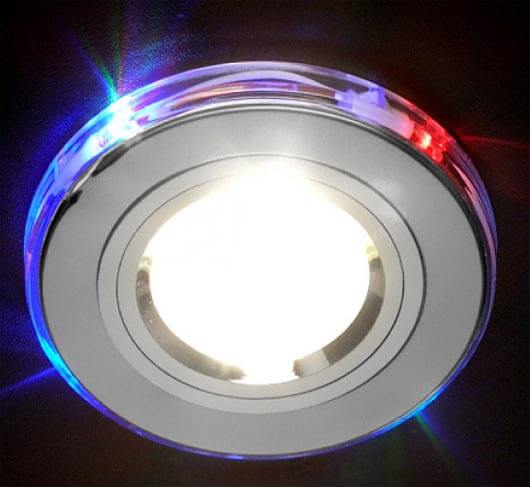
Advantages LED lamps:
- long service life - more than 100 thousand hours of continuous operation, which is a hundred times longer than the operating time of conventional incandescent lamps;
- natural spectrum of lighting;
- the ability to adjust the contrast and direction of light, greater clarity of the illuminated area; with their help, you can illuminate exactly the area of \u200b\u200bthe room that you need;
- LED bulbs for stretch ceilings are economical. consume 70% less electricity. Also, the savings lies in the absence of high costs associated with the replacement of lamps. Since they last for a long time, frequent replacements are not required.
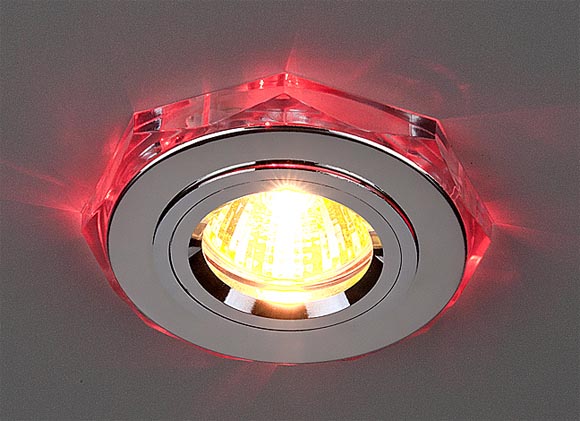
As for the disadvantages of LED light bulbs, they can only be attributed to considerable heat generation and a rather high cost.
Stretch ceilings with light bulbs have their own characteristics. First of all, you should pay attention to their power. So, incandescent lamps should have this parameter no more than 40-60 W, and halogen bulbs should be 30-35 W. The use of more powerful light sources leads to the fact that the body of the fixtures gets very hot, and this does not affect the stretch ceiling in the best way.
When installing lighting fixtures at the level of the ceiling structure, a holder is placed in the place of the future, which is attached to the ceiling. The design features of mortgage holders depend on the size and type of light bulbs.
Currently, the choice is not limited to incandescent lamps alone. The ability to use several types of lamps allows you to experiment with lighting, emphasizing the beauty of not only the ceiling, but the entire interior of the room.
Tension flow is not only a beautiful smooth surface, an attractive appearance and an easy-to-clean surface. This is another great opportunity to use built-in lighting! Therefore, the choice of fixtures for a stretch ceiling should be done with knowledge of all the subtleties of this matter. Let yourself imagine what kind of ceiling lighting you would like to see in your ceiling, and then it remains only to find the ideal materials to bring the idea to life.
LED lamps for stretch ceilings
LEDs are getting more and more popular these days. The fact is that these lamps, despite the considerable price, have all the qualities that the buyer would like to see in ceiling lighting. It is impossible not to note the special importance of the LED lamp for stretch PVC ceilings.
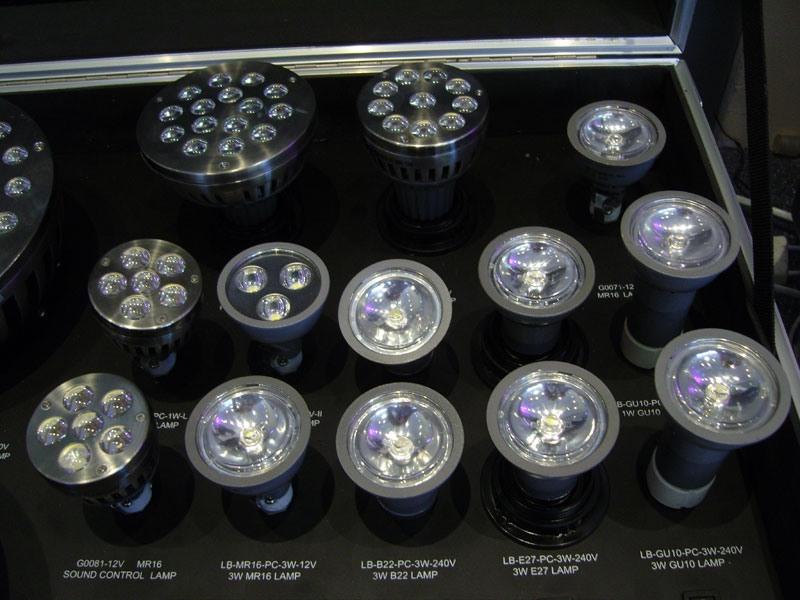
Why LED lighting is most often chosen for stretch ceilings:
- The fact is that this delicate material cannot coexist with a lamp that has a high temperature during operation. In this situation, the LED lamp will be the salvation.
- The shade of light that is emitted by the LED is very pleasing to the eye. It doesn't take many lights to completely illuminate the room.
- LED lamps are known for their durability. Quality models can last up to 10 years!
- LED lighting can be incredibly beautiful. Spot lighting with LEDs can change the color of the glow, and tapes and screens can create a natural doomsday on your ceiling.
In a stretch ceiling, LED lamps are what you need.
Halogen lamps for stretch ceiling
Halogen lamps are not very good for your stretch ceiling if it is made of PVC. But for fabric, halogens can work well. The problem with halogen lamps is that they get very hot during operation. This can melt the PVC, which will cause problems not only with the appearance of the ceiling, but may also be harmful to your health.
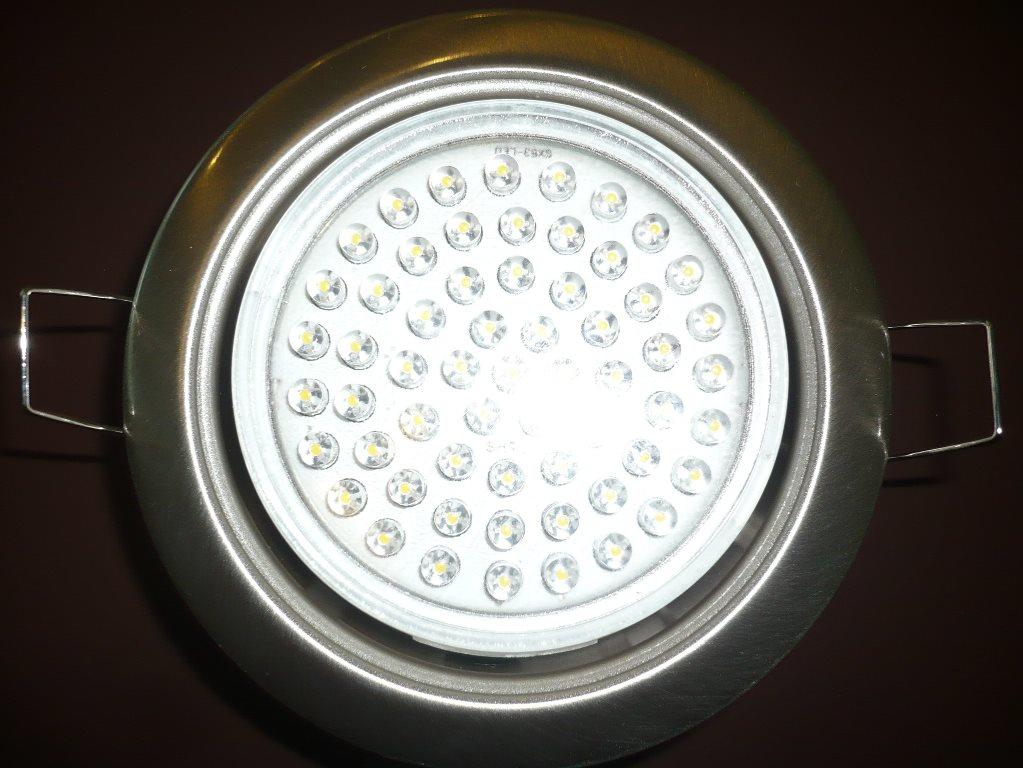
A halogen lamp will do if:
- You are going to light a ceiling chandelier, not a spot light. If halogen lamps are located far from the ceiling surface, then they will not harm the canvas.
- A fabric ceiling can withstand the heat of halogen lamps, and thermal rings will save your ceiling from discoloration.
- Halogen lamps may not be damaged if the spot is located on a hinge away from the ceiling surface.
Halogen lamps are inexpensive, beautiful and even durable. However, due to the heat, they cannot be installed close to the PVC surface.
Types of lamps for stretch ceilings
The ability to install built-in lighting in a stretch ceiling raises the question of which lamps are best used for this purpose.
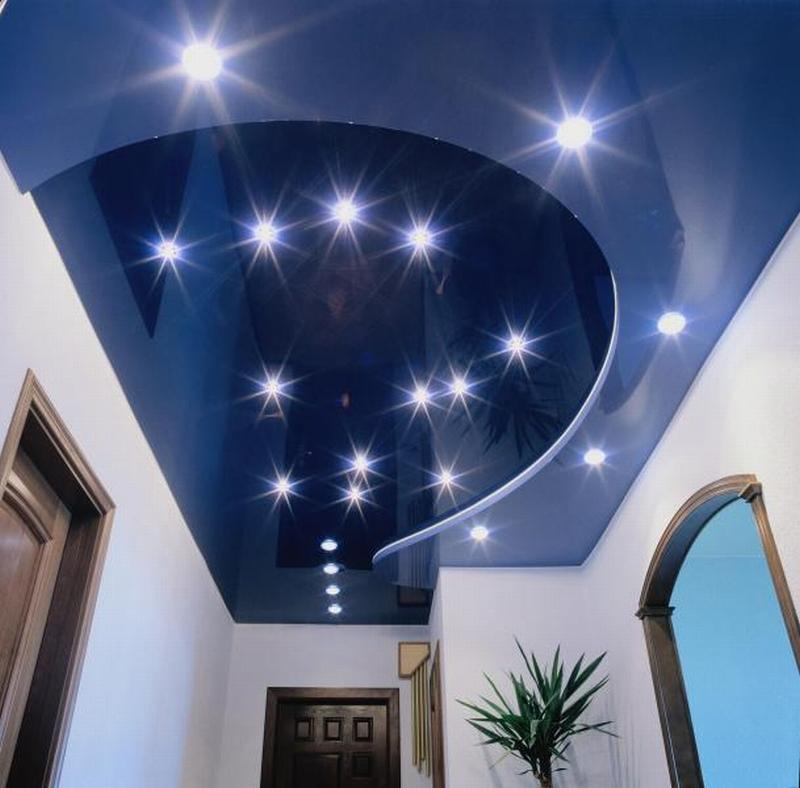
There are several answers to this question:
- An incandescent light bulb is an obvious solution that is not very good for a stretch ceiling. The fact is that the huge heating of these lamps can distort the shape of the ceiling, as well as change their color. Therefore, it is better to refrain from using incandescent lamps with a stretch ceiling.
- With halogen lamps, too, not everything is so smooth. Its heating is almost the same as that of an incandescent lamp, but it will still work if your lighting does not come into direct contact with the ceiling. In addition, a halogen lamp is much more durable if you follow the rules for its operation.
- The fluorescent lamp has a relatively low heat, which allows it to be used for a fabric ceiling without hindrance. However, its problem may lie in the fact that it does not withstand problems with voltage drops and even with changes in air temperature. However, the pleasant color of the glow and durability attracts many.
- Despite the impressive pricing of LEDs, you will find LEDs to be the best friends for your PVC ceiling covering! In addition, low energy turnover will allow you to forget about fabulous electricity bills.
It is not worth taking risks for the sake of an imaginary benefit and installing lamps that are not designed for your ceiling. The real benefit lies in the assurance that the ceiling will retain its original appearance, and the lighting will be of high quality and inexpensive.
Luminaires in the stretch ceiling: fluorescent light bulbs
The operating temperature of the fluorescent lamp allows it to be used for any type of ceiling. However, it is still worth taking precautions: surround the lamps with thermal rings to be sure that your ceiling is safe.
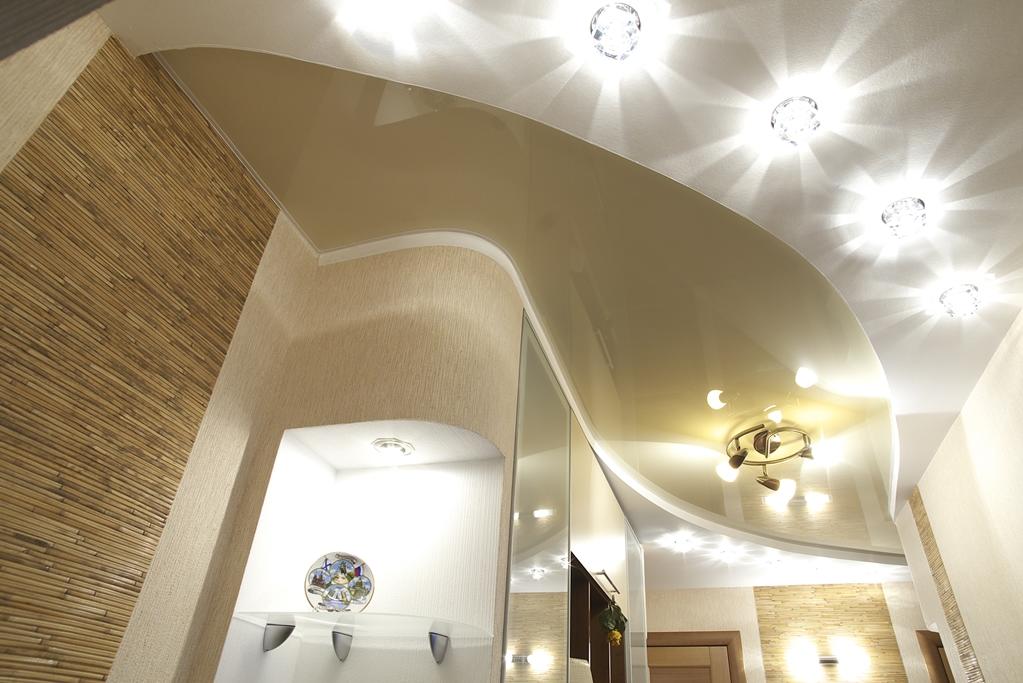
Fluorescent lamps have a number of disadvantages:
- When the air temperature is low, the fluorescent lamp will not light up. The mark of 10 o C is considered low for it.
- The fluorescent lamp does not fail at the same time. It slowly begins to lose the intensity of the emitted light.
- A power surge, even a slight decrease in it, can cause the lamp to stop working.
In general, if you do not pay attention to these shortcomings, fluorescent lamps can do a good job for a stretch ceiling.
We install spotlights for stretch ceilings
Installing a lamp when replacing or installing it for the first time can seem like a daunting task. Let's look at how to properly insert the lamps into the stretch ceiling.
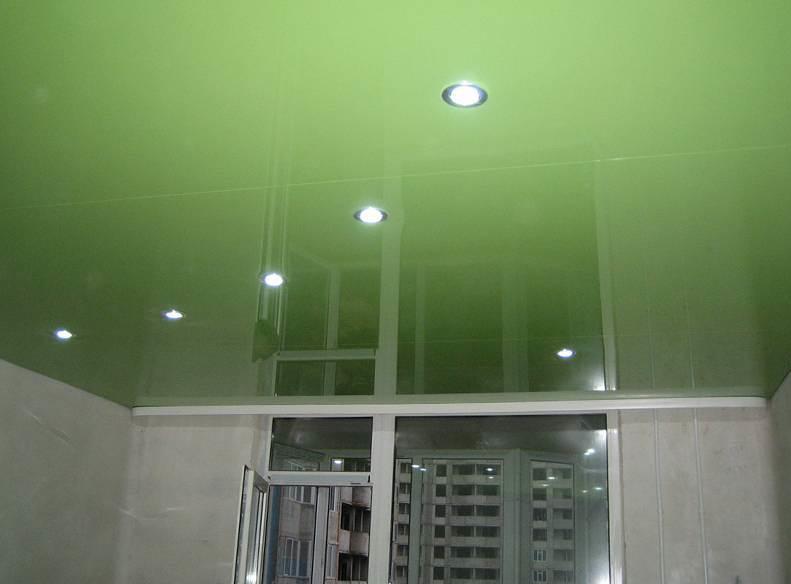
How to insert a spotlight correctly:
- To begin with, make sure that the lamp you are going to insert works, so that there will be no later disappointment from wasted labor.
- Turn off the electricity in the room, or better - in the entire apartment.
- Remove the wiring from the hole for the lamp and connect the wires.
- Put the insulation on the joint
- Insert the new lamp into the hole, carefully holding the clothespins along the edges of the lamp. Screw the lamp to the box with special screws.
It is not difficult to replace or insert a lamp into a stretch ceiling!
Stretch ceiling: light bulb design
The design of the lamps is the most diverse! This distinguishes ceiling spotlights from any other types.
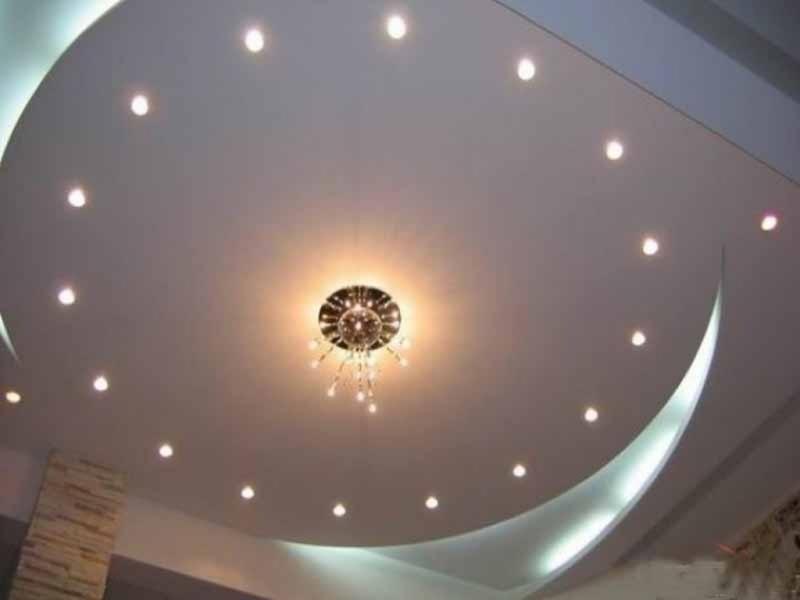
The main parameters of the design of spotlights.
- Overhead or cut. Cut-out lamps are inside the ceiling, and overhead lights stick out a little under it. The latter have a greater potential for luminescence, while the former look more accurate.
- Swivel luminaires are equipped with a hinge, thanks to which they can change the direction of the glow, while fixed ones are built into the ceiling in a static state.
- Luminaires with shades may have diffused light. Without a plafond, the lamp shines directionally.
Choosing a lamp design is not an easy, but enjoyable job! Choose with pleasure.
How to choose light bulbs for stretch ceilings (video)
Different types of lamps allow you to choose the best option for ceiling lighting. The power of the lamp, its energy efficiency, glow temperature and other parameters distinguish the lamps from each other, allowing you to have a choice.
To illuminate rooms with stretch ceilings, pendant and spotlights (recessed and overhead) are used, and LED strip is used for decorative lighting of rooms. When choosing lamps, the owners of apartments and cottages are primarily interested in the design of these electrical appliances. The specialist will say when choosing luminaires, the types of lamps are decisive. Lamps and lamps for them are individually selected for different interiors. The choice of lighting fixtures depends on the type of room and the tasks that lighting fixtures will solve.
The choice of lamps for rooms with stretch ceilings
For rooms with stretch ceilings are suitable only halogen and energy-saving (fluorescent and LED) lamps. Energy-saving lamps give an even bright light and do not overheat the ceiling canvas. LED lights consume less energy, heat up less, wiring for these lighting devices takes up less space.
Energy saving lamps (fluorescent and LED)
Unlike incandescent lamps, energy-saving lamps have a high light output. Energy savings are achieved by the fact that with less power they create an intense, bright light. There are several dozen types of fluorescent energy-saving lamps. They differ in size, design of the flask, parameters of the socles and the color of the created luminous flux(the light of these lamps can be daylight, warm, cold or neutral white). In the light spectrum of these lamps there is ultraviolet radiation, so they should not be placed closer than 30-35 cm from the eyes.
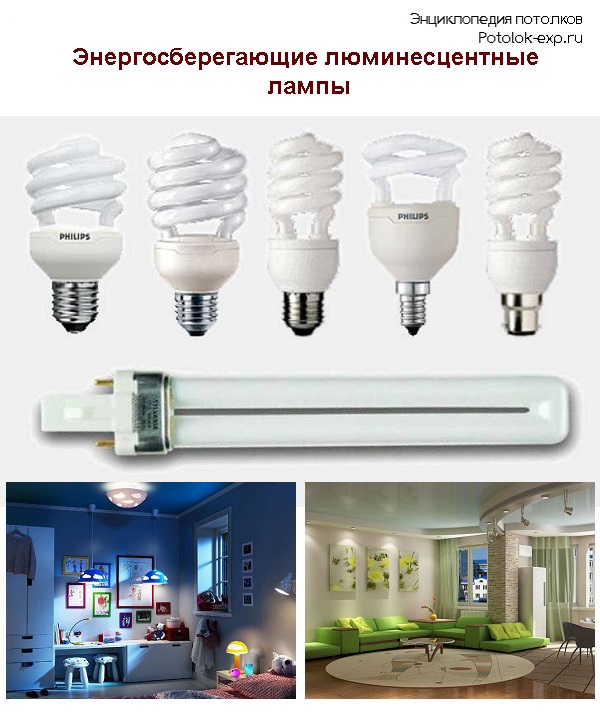
Light output at LED lamps higher than fluorescent ones. They do not have tungsten filaments (like incandescent lamps) and a fragile glass bulb (like fluorescent lamps). These lamps do not burn out from frequent switching on and off and create a comfortable, almost natural, light for the eyes.
LED lamps last much longer than others. They begin to shine at full power immediately after switching on. It takes about 30 seconds for a fluorescent light bulb to light up completely.
In energy-saving lamps, the intensity of the glow changes in accordance with the frequency of the current in the network, which may cause discomfort for some people.
Halogen lamps
Halogen lamps are classified as incandescent lamps. They can have different shapes, different plinths, different compactness and different designs. Vapors of bromine or iodine are added to their cylinders.
The lamps have good color rendering and light output. These lighting devices do not burn out during voltage drops, have high strength and a long service life. Currently, many types of halogen lamps with a small bulb are produced, which, in particular, allows them to be used in interior spotlights. Do not touch the flask with your hands, as fatty particles on your fingertips, remaining on the quartz glass of the device, can lead to its burnout. The light bulb can only be touched with a clean cloth or napkin.
Halogen lamps can also be used for stretch ceiling fixtures if their power is less than 35 watts.
Lamps for lighting rooms have a different design. Consider the features of using lamps with different bases.
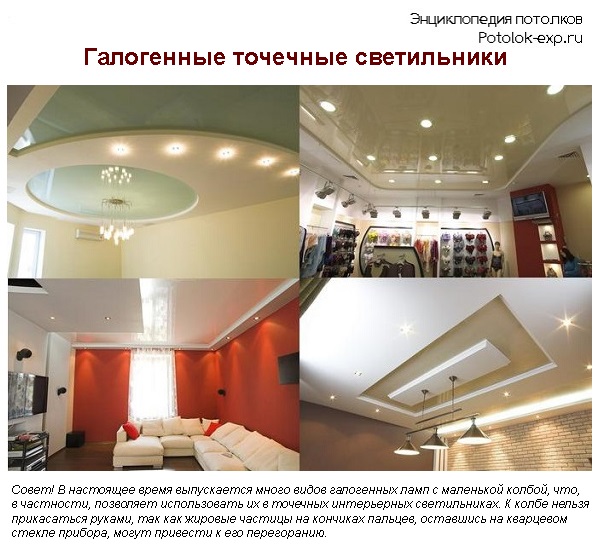
Base lamps G5.3
Lamps with a G5.3 base can be halogen or LED. Halogen lamps, released several years ago, have one drawback - their reflector is translucent, so it transmits light behind the lamp (for the stretch ceiling canvas).

As a result, all elements of technical structures become visible - wiring, embedded parts for lamps and fixtures. Five to ten years ago, the problem was solved simply - the back of the ceiling was covered with foil or special refractory paint. Now there is no need for such an “improvement”, since there are halogen bulbs on sale with a bulb covered in the end part with an opaque layer.
The disadvantage of the G5.3 model is that the light bulb is located deep inside the ceiling, from which the light comes out at an acute angle and does not scatter at all.
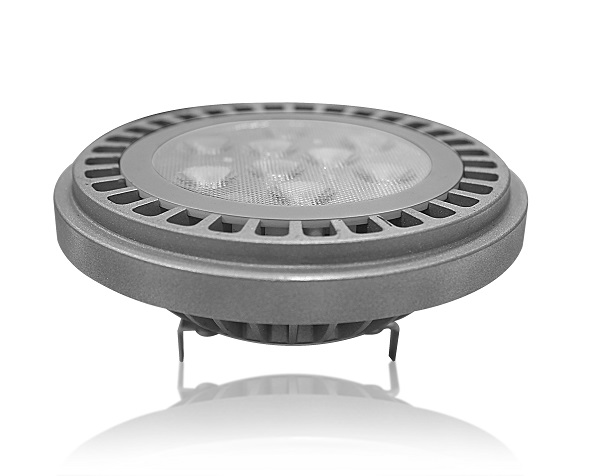
Lamps with GX53 base
In the GX53 model, the light bulb is not recessed inward, it protrudes from the plane of the structure. The height of the protruding part is 4-5 mm. The angle of the glow of such a lamp is as wide as possible, the light spreads almost 180 degrees. With GX53 base, LED and energy-saving lamps are produced.
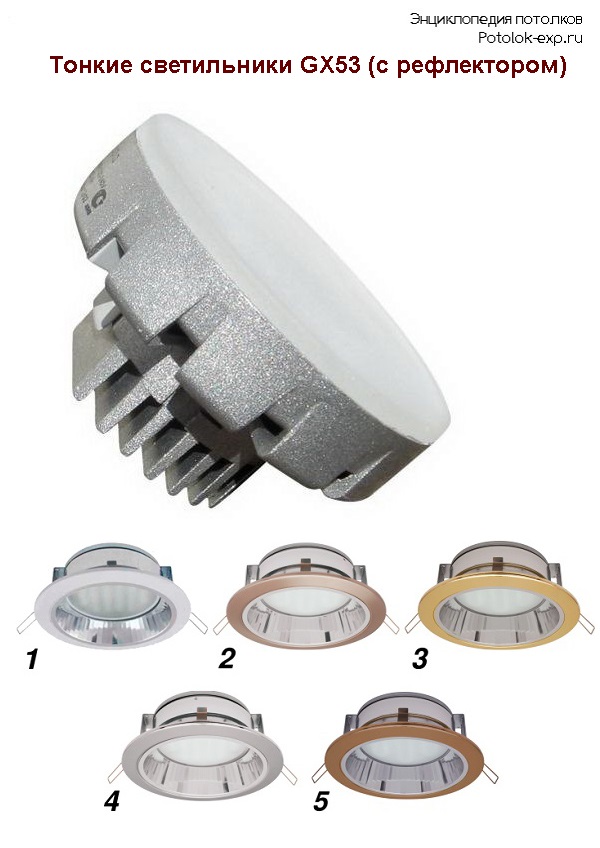
Lamps with G9 base
The main difference between lamps with a G9 base and previous versions is that the bulb protrudes completely from the ceiling, as a result of which the light is as diffused as possible. In terms of glow efficiency, they are superior to the model with a base G5.3, but behind the model with the GX53 base.
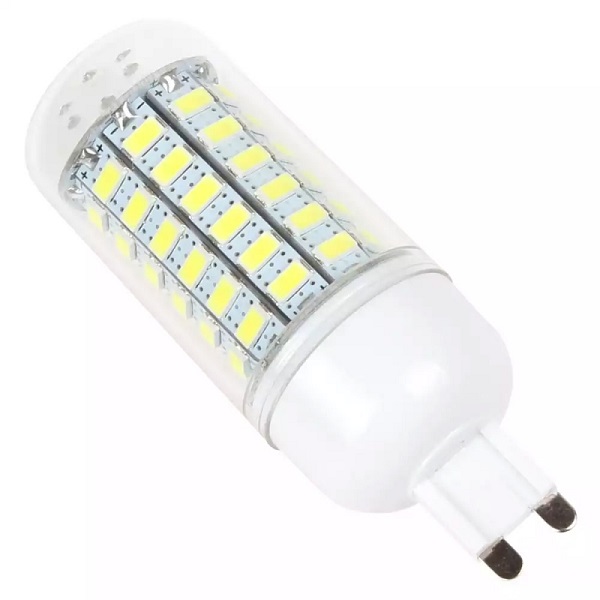
When buying an LED light bulb, you should pay attention to the design of the device. There must be a metal cooling grill around the bottom. LED bulbs do not heat up to high temperatures, but they still heat up, and this heat must be removed. Overheating the device greatly reduces its service life. On average, such a lamp with a cooling grate works for three years, with a manufacturer's warranty of about one year.
Tables. Norms of specific illumination of the luminous flux for residential premises.
| room | Index |
|---|---|
| 22 W/1 sq.m. |
| 15 W/1 sq.m. |
| 26 W/1 sq.m. |
| 60 W/1 sq.m. |
| 20 W/1 sq.m. |
| 12 W/1 sq.m. |
Note: data derived from the use of incandescent lamps.
Spotlights
Spot (overhead and built-in) lamps are an integral part of modern living space. Proper lighting able to emphasize the beauty of the interior and hide its flaws. Technically well-placed lamps create a comfortable environment for the eyes.
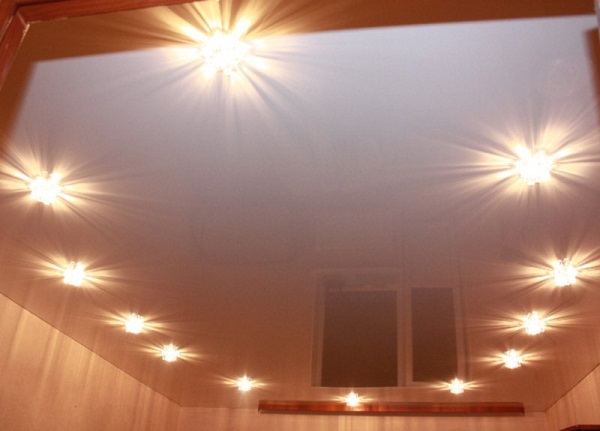
Spotlights are best suited for additional lighting large rooms such as living rooms, bedrooms, children's rooms, dining rooms. As the main lighting, they are good for small rooms - bathrooms, toilets, dressing rooms and corridors. In small rooms, point sources evenly distribute light over the entire ceiling area. This allows you to equally illuminate all parts of the room.
The electrical equipment needed to connect the lamps occupies a certain part of the space of the house. The size of the niche above the stretch ceilings depends on the type of luminaire. If wiring is installed for halogen or fluorescent lamps, the stretch ceiling is placed approximately 8-12 cm below the main one, for LED spotlights - 6 cm.
Since the corridor and the entrance hall are the passage part of the apartment or house, the lowered ceiling will not be striking. In spacious hallways, a small chandelier can be installed as the main lighting, and built-in lamps can be used as an additional light source.
If only spotlights are turned on in the room, a calm, peaceful atmosphere with soft subdued light is created. If the designer wants to emphasize the different levels of the stretch ceiling and decorate its protruding part, then you should first choose a chandelier, and select spotlights under it.
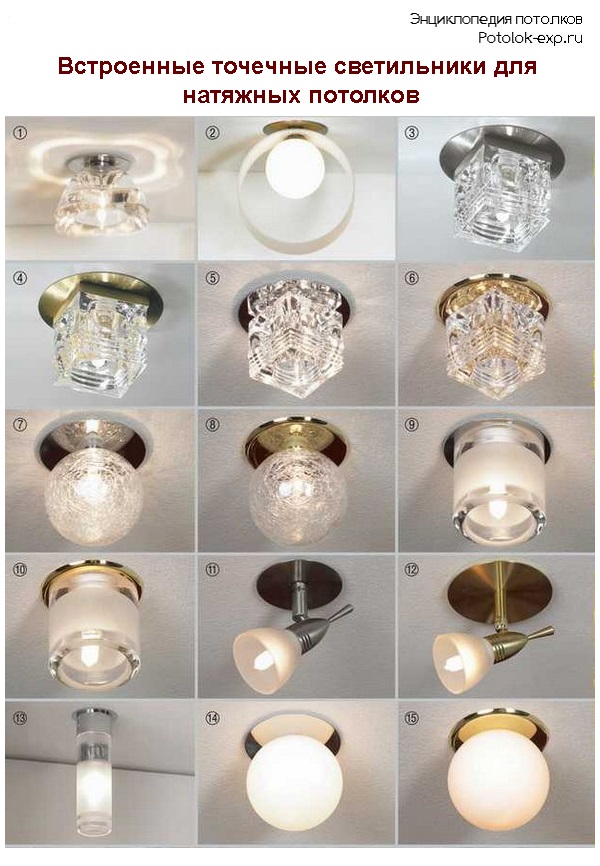
Spotlights can be rotary and fixed. Rotating shades are designed to direct light only to a specific area - a desk, a section of a kitchen table or a wall to show off its texture.
According to the degree of protection against moisture, these electrical appliances are divided into waterproof lamps and lamps for dry rooms. The choice of moisture-proof electrical appliances is very important if they are to be installed in bathrooms, toilets and basements.
In the lighting market, you can see hundreds of types of spotlights. They are made of a wide variety of materials - glass, gypsum, aluminum, crystal, plastic. Plafonds are decorated with stained glass overlays, rhinestones, carved wooden elements, metal openwork details. If, according to the designer's idea, the lamp should be hidden or inconspicuous, you can choose the most minimalistic option (a white lamp with the same white ring around it).
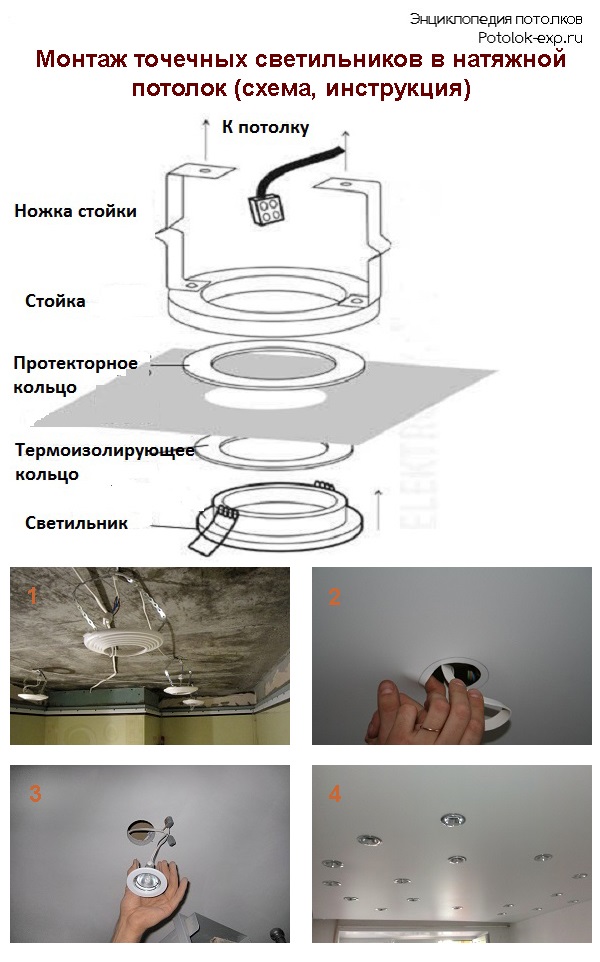
Design modern apartments and private houses are very diverse - you can find many styles in their decoration, from loft and baroque to hi-tech. A rich selection of spotlights does not limit the imagination of the designer and the customer.
Crystal spotlights are interesting and very beautiful. They can scatter light, creating beams and patterns on the ceiling and walls. These electrical appliances are issued in different styles. Art Nouveau lamps have a geometric, square or rectangular shape of decorative elements; in classical style models, you can see hanging details made of glass or crystal. Models in the style of "floristry" combine combinations of glass leaves, buds and petals. Especially beautiful are crystal lamps with built-in LEDs at the edges or inside.
A crystal lamp will not cast glare if a lamp with a matte finish is inserted into it. For the same reason, it is not recommended to put fluorescent light sources in it. LEDs are the ideal choice in this situation.
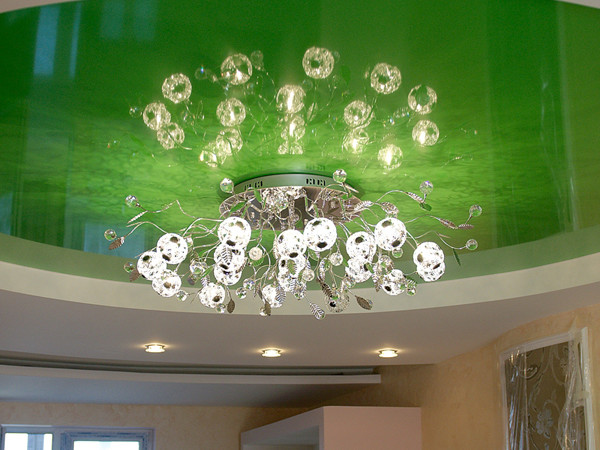
Chandeliers and hanging lamps
Chandeliers are designed to illuminate the entire room, but the center of the room receives most of the light. These electrical appliances can be of any size, only the size of the room and the height of the ceiling impose restrictions on the choice. The higher the ceiling, the more freedom of choice the owner of the premises has.
Pendant lamps with one ceiling is often mounted in rooms with multi-level false ceilings. They are designed to illuminate a specific area in a room.
A chandelier may consist of one or more ceiling lamps, which are located at different distances from each other and at different heights. The choice of this lighting device depends on the style of the room and the tastes of its owner. In any case, the chandelier should be installed by a professional who knows all the intricacies of installing electrical appliances.
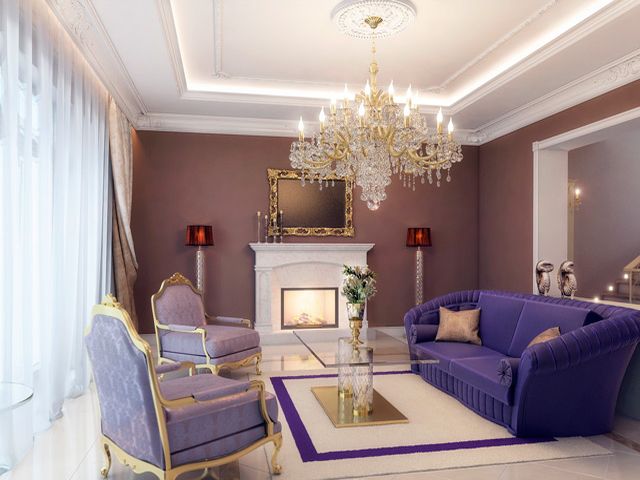
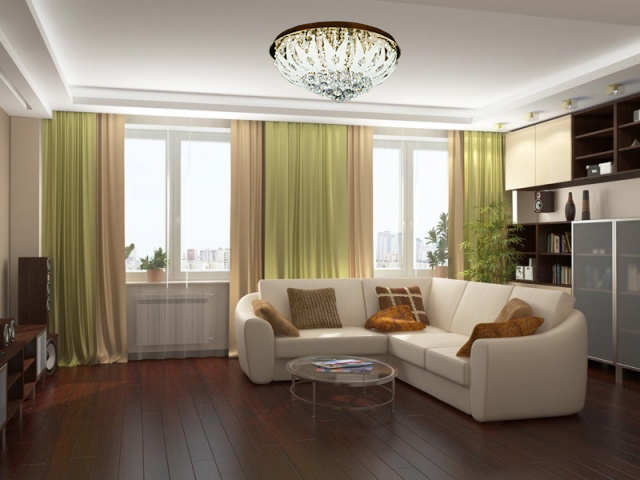
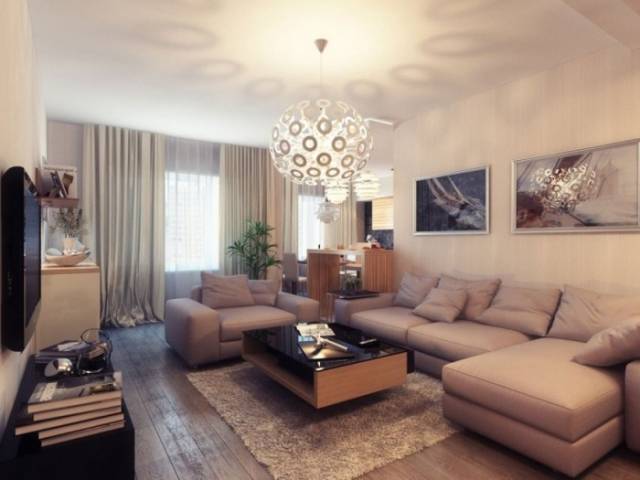
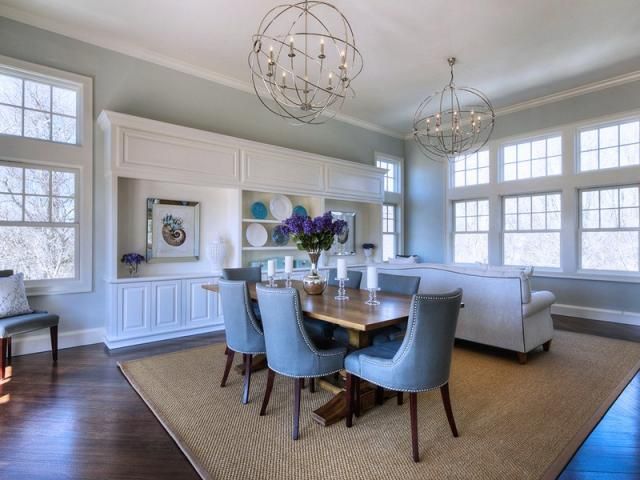
Chandeliers with multiple bulbs can reach significant temperatures. If the ceiling temperature exceeds 60 degrees, the ceiling will begin to turn yellow, darken, it may sag, and eventually lose its beautiful appearance. Depending on the lamps used, the distance from the chandelier shades to the ceiling should be at least 15-60 cm.
Energy-saving lamps and lamps with LEDs give minimum temperatures during operation. They are used in chandeliers located in close proximity to the ceiling, they are ideal for chandelier-plates.
The distance from the plafonds to the ceiling depends not only on the type of light sources used, but also on the direction of the plafonds. If the ceiling lamps are directed with bells upwards, the safe distance will be maximum.
For light decoration, LED strips are used, less often - lamps with special diffusers-nozzles. LED strips are a flexible, transparent plastic strip in which small spotlights are mounted. The thickness (3 mm) and width (1 cm) of the strip allows you to hide it behind the stretch ceiling structure, for example, behind a ceiling plinth.
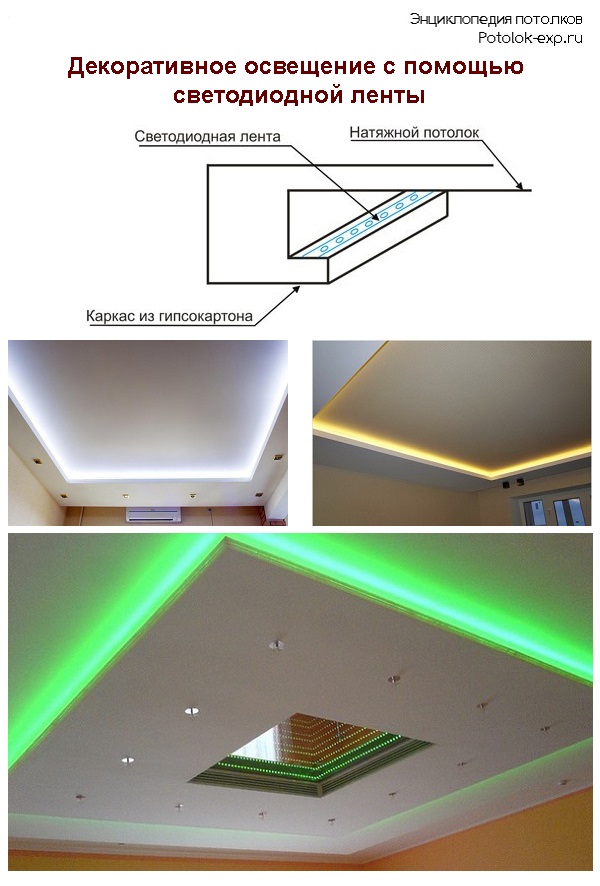
Decorative lighting of this type has a number of advantages.
- Backlighting, hidden behind a ceiling plinth or decorative panels, gives a completely diffused light.
- Hidden lighting does not affect the visual perception of the height of the room.
- LED strips do not need to be decorated in any way.
- Installation is done in such a way that air is constantly supplied to the light sources.
- Illumination can further reveal the advantages of the design of the room.
LED strips are mounted around the perimeter of the room or in a certain area according to the project. With this lighting device, you can create either stripes of light, or individual luminous areas of a geometric or arbitrary shape.
The color of the light sources can be very diverse. Such lighting fixtures are fireproof and easy to install.
The ceiling canvas plays the role of a ceiling lamp for the LED strip, hidden in the eaves along the perimeter. The decorative light turns out to be even, matte, and the dots of the LEDs on the tape are not visible behind the cornice.
The flexible plastic base of the LED strip is the board and conductor of electricity. For operation, the device is supplied with a current of 12-24 V. Mains power is supplied through the converter unit. If the design allows you to adjust the voltage, then a controller is used. You can also control the voltage in the LED strip from a special remote control. The tape is easily glued to degreased metal ceiling structures (to do this, it is enough to remove the protective film from the adhesive layer).
Decorative lighting "Starry sky"
For decorative lighting in the style of "Starry Sky" LED lamps are also used. To get a picture on the ceiling, you need to arrange the LEDs in a certain way (arbitrarily or in the form of constellations).
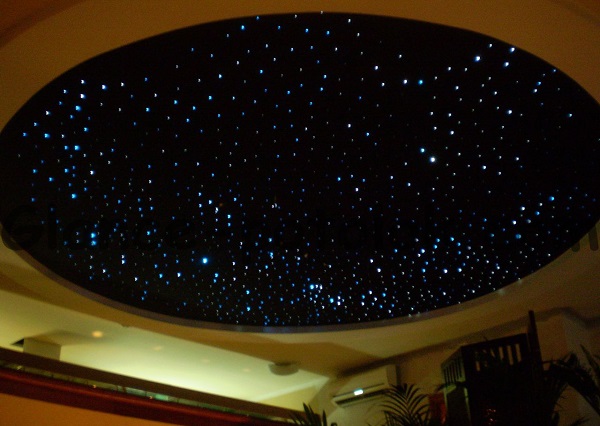
Stretch ceiling "Starry sky"
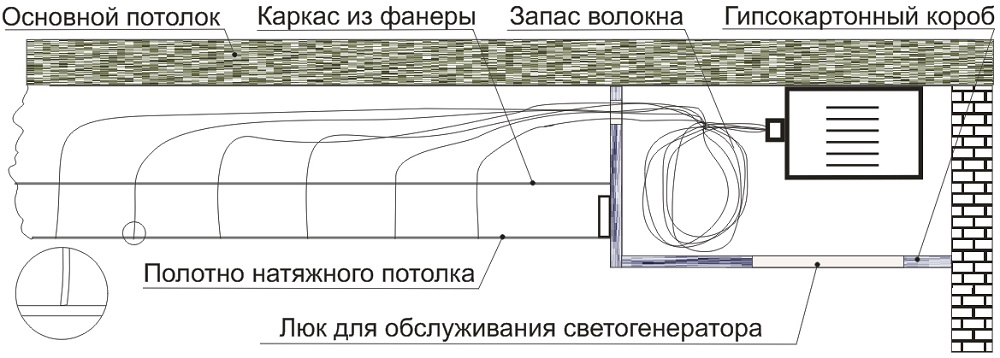
The scheme of the stretch ceiling "Starry sky" with optical fiber
LEDs are mounted on a rigid frame and interconnected. Then the wires are led to the control panel. Small bulbs are displayed through the material of the ceiling. From the control panel, you can change the brightness of the "stars". The effect of the "starry sky" is also created by projecting slides on the ceiling and using a Swarovski glass lens.
Video - Which fixtures are best for a stretch ceiling and why
During the repair of the hallway, the question arose about the choice ceiling lights. I didn’t have to choose the type of ceiling, since I had experience working with stretch ceilings. A stretch ceiling made of PVC film was chosen. I had to think about which lamp to install on the ceiling. I wanted to have modern beautiful lamps, and at the same time I didn’t want to part with the homemade chandelier and sconces that hung in the hallway.
The choice has been made. The chandelier and sconces remained hanging on the ceiling in the hallway, but in the corridor I decided to purchase spotlights, since a single-lamp hung on the wall. Before mounting the stretch ceiling, you should stretch the wires. To do this, you need to make a drawing of the electrical circuit, which includes the number of lamps, the type of light bulbs, their power.
To date, 4 types of lamps have become widespread:
- Incandescent;
- LED;
- Halogen;
- Compact (energy saving).
Each type has both positive and negative sides. In addition, when choosing lamps, one should take into account their parameters, such as the distance between the fixed and suspended ceilings. From the table below you can find out the characteristics of the lamps, choose the one you need for your ceiling.
| Table for selecting the type of bulbs for recessed ceiling luminaires | ||||
|---|---|---|---|---|
| Technical specifications | Lamp type | |||
| incandescent | Halogen | energy saving | LED | |
| Minimum distance between main and suspended ceilings*, cm | 10-12 | 5-6 | 10-12 | 5-6 |
| Supply voltage, V | 220 | 12, 220 | 220 | 12, 220 |
| Luminous flux*, Lm/W | 10-15 | 15-20 | 50-70 | 80-120 |
| Maximum power*, W | 40 | 40 | 40 | 7 |
| Color temperature, °K | 2700 | 3000 | 2700, 3300, 4200, 5100, 6400 | 2700, 3300, 4200, 5100 |
| Service life*, hour | 1000 | 4000 | 8000 | 70000 |
| Price | Very low | Low | Medium | high |
Specifications may differ from those in the table. It depends on the type of lamp, design, type of ceiling. For example, there are ceilings that are afraid of heating more than 60 degrees. This limits the choice of lamp.
Halogen lamps are afraid of voltage drops, so they often burn out. They are designed for both 12 V and 220 V. Lamps operating at 12 V require a step-down transformer, a power supply. Therefore, when installing such lamps, do not forget about the space in the wall or ceiling for its installation.
Calculation of power and number of fixtures
When choosing the power of the lamp, you should take into account the size of the room, the color of the furniture. Choose a lamp should be based on their taste. With the help of the table, you can find out how much power the fixtures will need. Calculations were made based on the values of the luminous flux, the type of lamp.
| Table for calculating the power and number of fixtures depending on the type of room | ||||
|---|---|---|---|---|
| Room type | The power required to illuminate 1m 2 of the area of the room depending on lamp type |
|||
| incandescent | Halogen | energy saving | LED | |
| Children's | 40 | 30 | 10 | 5 |
| Kitchen | 30 | 25 | 7 | 4 |
| Living room, bathroom, toilet | 25 | 20 | 6 | 3 |
| Bedroom, hallway, corridor | 20 | 15 | 5 | 2 |
| Utility rooms | 10 | 7 | 2 | 1 |
It was planned to install spotlights in the corridor. Here are the calculations that were made.
The corridor looks like the letter T. The plot area is 4.5 m 2, 2.8 m 2. The total area is 7.3 m 2. The required power of the fixtures should be 15.6 W (7.3 × 2). The height of the ceilings in the room is 2.75 m. It was planned to paint the walls in the color of creme brulee. Since the corridor has a complex shape, it is necessary to install 4 lamps, the lamps of which will have a power with a margin of 5, W. Power supply 220 V, pin base GU5.3. Such a plinth is popular due to its small dimensions, which allows it to be installed at a low height of the interceiling space.
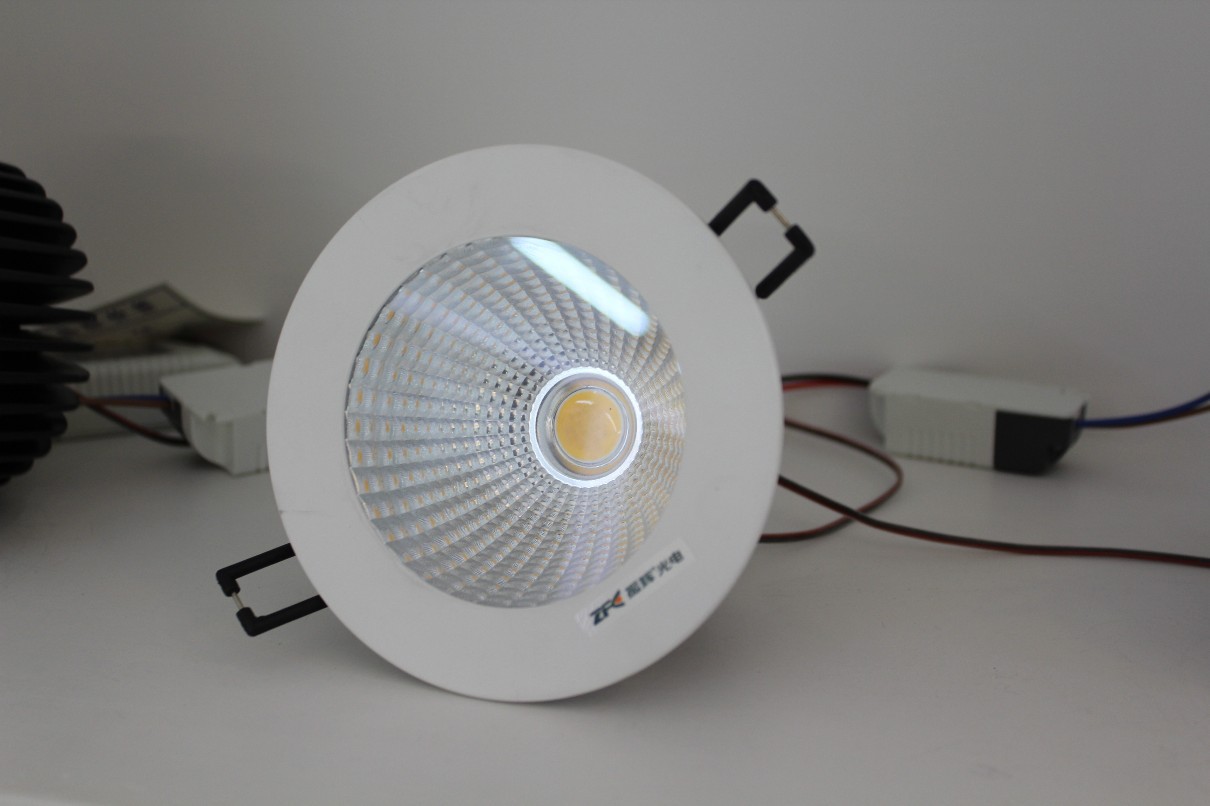
The walls of the corridor were decorated with paintings that were planned to remain after the renovation. Based on this, I chose lamps white color, whose color temperature is 4000 K. If you want to achieve warm light, lamps with a color temperature of 2700 K are suitable for you. Note that room lighting does not always have to consist of ceiling lights. It is better to reduce the power of the lamps and place a couple of wall-mounted ones on the wall.
If there is local lighting, then the ceiling can be illuminated led strip. Everything is limited by your imagination.
The choice of wire for wiring spotlights
To power 4 lamps, any wire that has double insulation will do. It is better to choose a copper double connecting wire that has many strands. For example, PVA 2 * 0.75. The cross section will not play a big role, since the current will not exceed 0.1 A. If 12 V halogen lamps are used, then the wire cross section must be calculated. One lamp with a power of 60 W consumes a current of 5 A.
Selection and installation of a recessed spot ceiling lamp
On the shelves of shops you can find a lot of lamps. But they all have the same design and differ only in appearance. Some models have the function of changing the direction of the light flux.
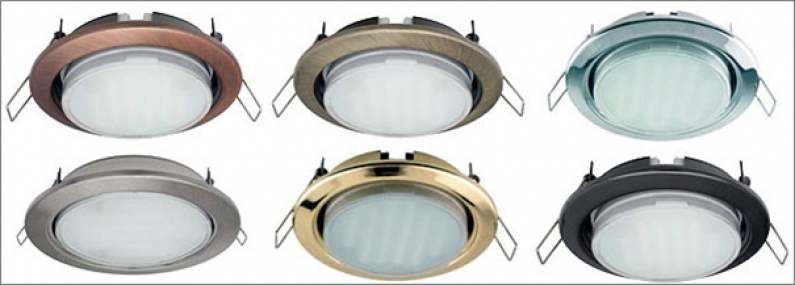
Since I need to illuminate the corridor, the simplest lamps with a base cartridge were chosen.
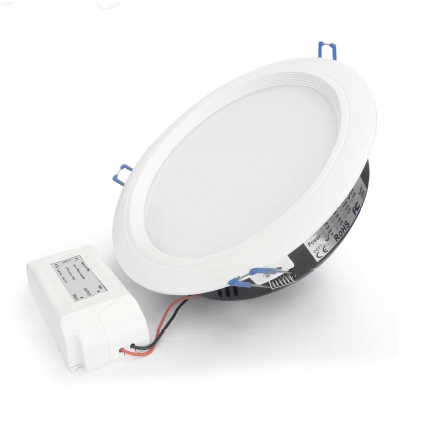
Each luminaire has a body that looks like a figured ring, and platforms with lugs for mounting under springs. Its shape depends on the type and power of the lamp, as well as the presence or absence of a cartridge (usually E14).
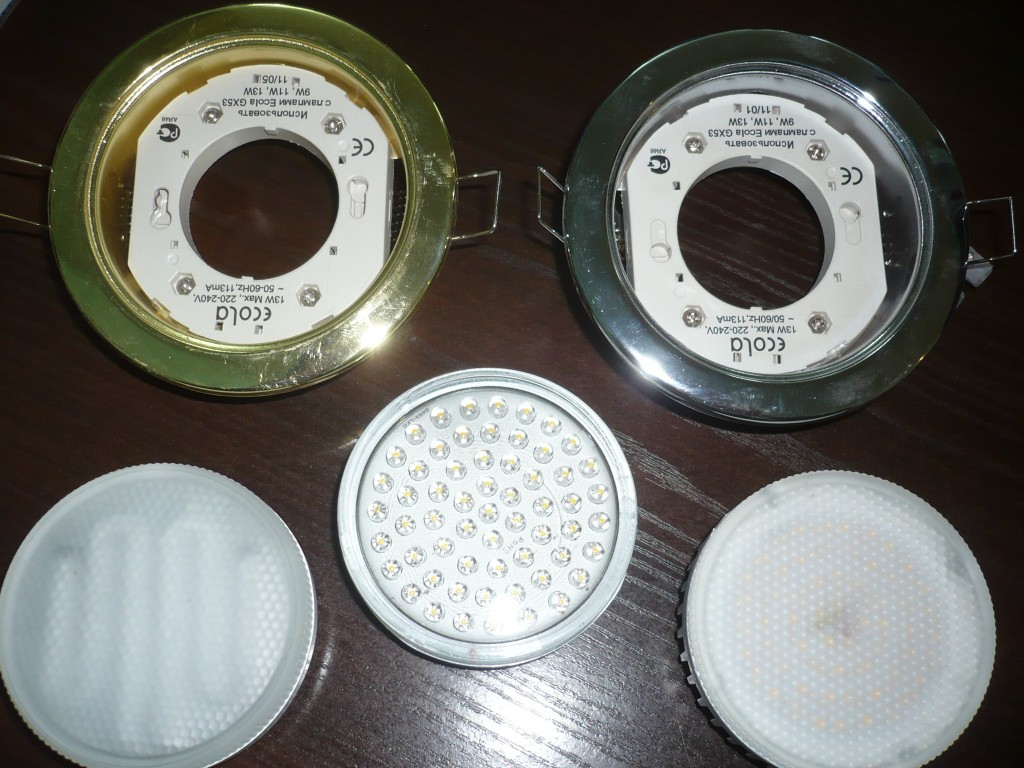
A separate niche is occupied by lamps, the LEDs of which are placed on a printed circuit board.
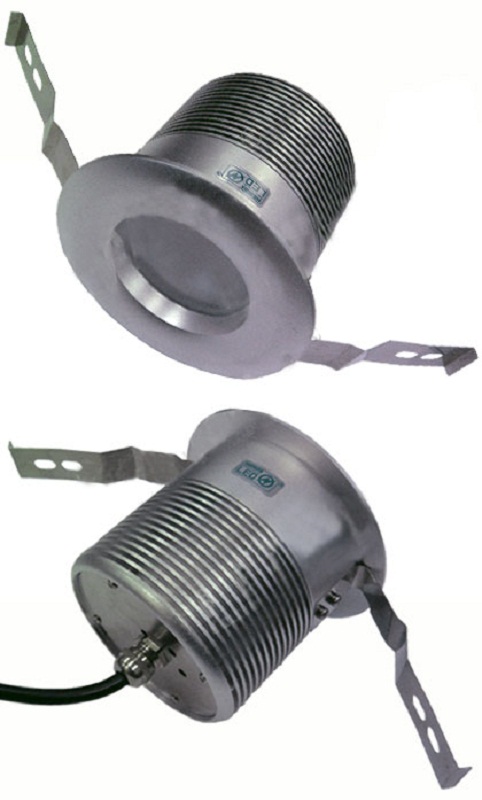
If it fails, the light bulb cannot be replaced. You will either have to change the entire lamp, or look for LEDs. Yes, and its price is not too small. Lamps that do not have a cartridge press the lamp with a spring in the form of a cut ring.
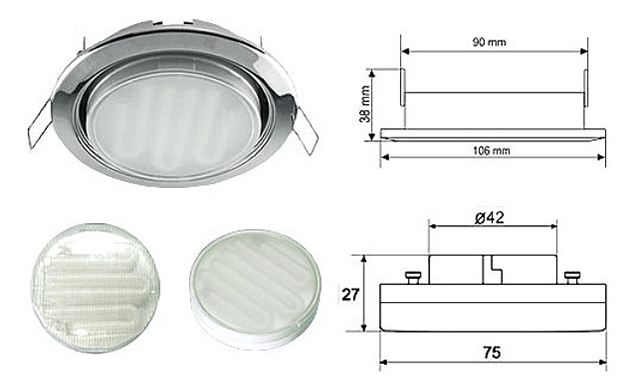
The lamp is inserted due to the fact that the ring is unclenched and enters the groove located in the housing. This lamp is suitable for both LED and halogen lamps. Just do not forget about the supply voltage that the lamps can withstand. To fix the lamp in the ceiling, it is necessary to make a hole at the location of the lamp, which will be slightly smaller than the outer diameter of the housing flange.
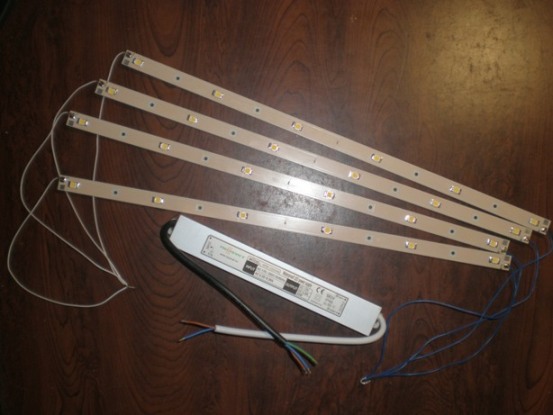
The ears of the springs must be parted to such an extent that they pass into the hole made. Then they can be released. Leaning on the ceiling, they press the luminaire against the flange until it stops, which allows the luminaire to be fixed.
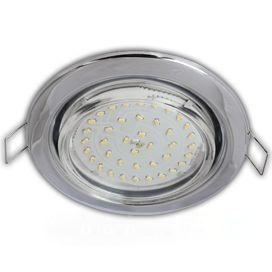
After fixing the lamp in the ceiling, we pass the wire and connect the cartridge with the terminal block. The cartridge must be put on the base, the lamp must be inserted into the lamp body and, having opened the spring, fix it.
Wiring diagram for spot ceiling lights
Before installing the ceiling, attention should be paid to the choice of the type of lamps, the number of lamps, their location, and the choice of power. To do this, you need to develop an electrical circuit. During its development, the method of attaching the wires to each other and the points at which these wires are connected are taken into account.
![]()
Since wires came out of the wall on which the lamp was located, they will be used to mount ceiling lamps. Since there will be no access to the wires after installing the stretch ceiling, they must be fastened in a reliable way. I settled on twisting with soldering with tin-lead solder. These points are marked on the diagram.
If you plan to place such lamps in a room where a computer or TV is located, you need to consider that the angle of incidence of the beam on the surface is equal to the angle of reflection. Therefore, such lamps cannot be placed above the equipment, as there will be a reflection from the monitor. Before planning the lamp, you need to consider the arrangement of furniture and appliances in the room.
If the lamps are powered by 220 V, optional equipment not required, but if they need 12 V, then it should be noted that under the power source of these lamps you need to make a place that will have free access for maintenance.
Installation of electrical wiring for connecting spot ceiling lights
After purchasing all the necessary fixtures and wires, you can get to work.
![]()
Electrical wiring can be installed at any stage of repair work. Even before installing a stretch ceiling. During the repair of the walls, the light turned out to be dim. I had to connect temporary cartridges into which energy-saving lamps were screwed.
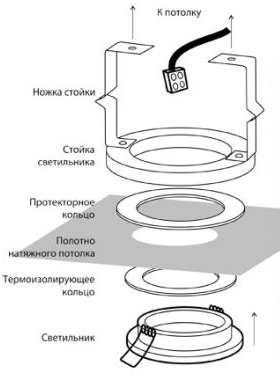
Before installing the wires, select and mark the location of the fixtures. The photo is marked with circles. To prevent sagging wires, fasten them at intervals of 40 - 50 cm.
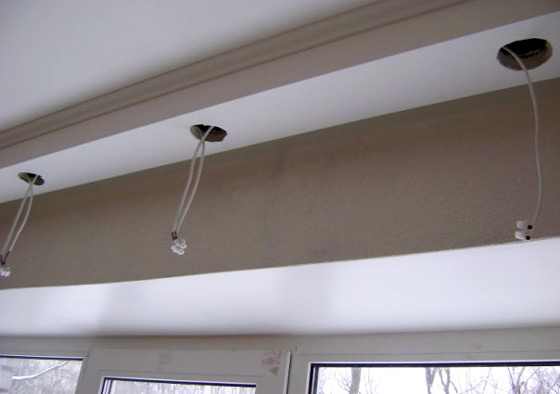
To fix the wires, you can use a dowel - clamps (left photo) or nail clips (right), which have different sizes. If the installation will be done with a dowel - with a clamp, drill a hole in the wall, put on the clamp and hammer the dowel into the wall. To secure the wire with a nail clip, press the wire against the wall and hammer in the nail. This installation is suitable for attaching the wire to plaster, wood, plastic.
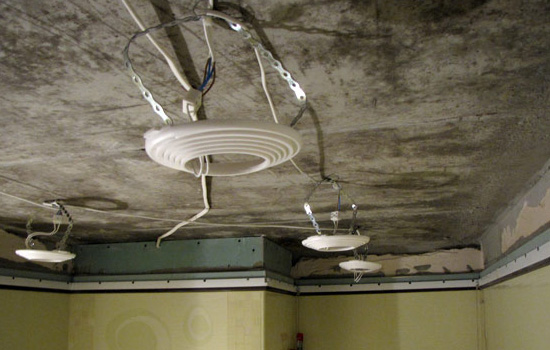
Nail clips are bad because the nail can fall out and the wire will lie on the ceiling. This mount was immediately thrown aside. The collars were not at home. Therefore, I applied the most easy way, which is based on fixing the wire to the wall with a PVC tube clamp. To do this, drill a hole in the ceiling, hammer in the dowel. We wrap the tube around the wire and fasten it with any self-tapping screw.
Making a wiring harness for ceiling spotlights
After installing the ceiling, access to the wiring will be limited. Therefore, the connection of the wires to each other must be carried out with high quality. Most often, the wires are connected with a terminal block, say "Wago". However, the most reliable method is soldering. I applied it.
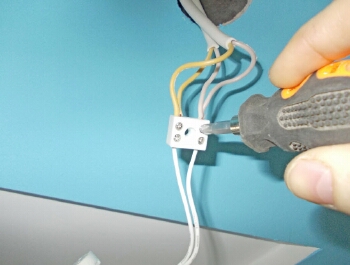
To minimize work under the ceiling, the harness was made in advance. It only remains to be attached to the ceiling and connected to the main wiring. To find out the length of the wires, it is necessary to make measurements between the places where the fixtures are attached. The results of the measurements were entered into the wiring diagram, which was the wiring diagram.
The bundle was made of stranded wires with double insulation. The core in such a wire is covered with PVC, entwined with a thread. To make it convenient to carry out the work, the wires were twisted into a pigtail.
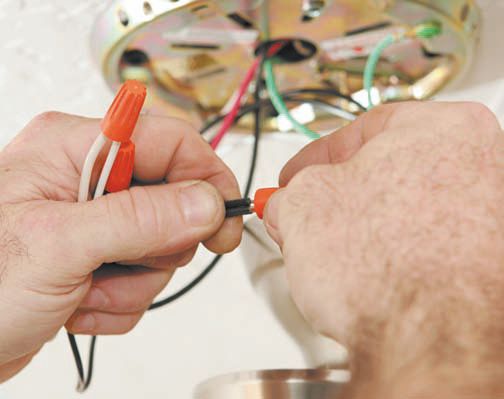
First of all, the insulation was removed from the wires, which allowed the wires to be irradiated with solder. The second compartment of the corridor implies a branching of the wires, so they were twisted and soldered. To increase the reliability of the insulation, the soldering points are shifted relative to each other.
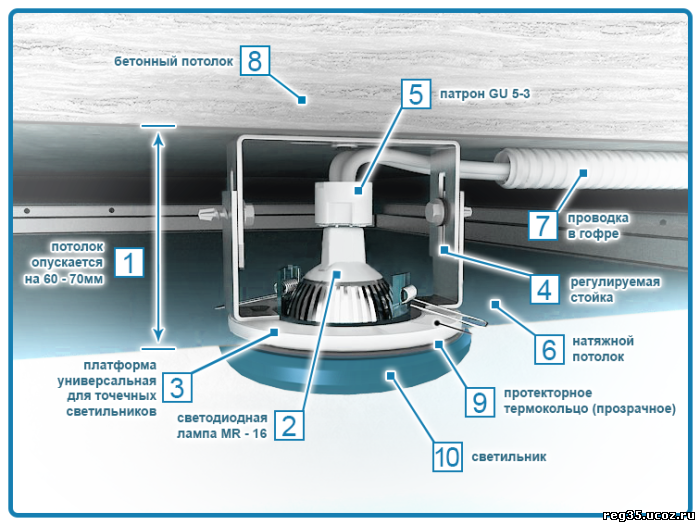
Tubes are put on the soldering points, which prevent short circuits. To prevent their movement along the wires, they should be fixed with cambric. It was possible to insulate the soldering points with the help of insulation tape. In order not to confuse the wires, the cambric was marked with a marker. Part of the wire was located under the plaster. In this place, a PVC tube was put on.
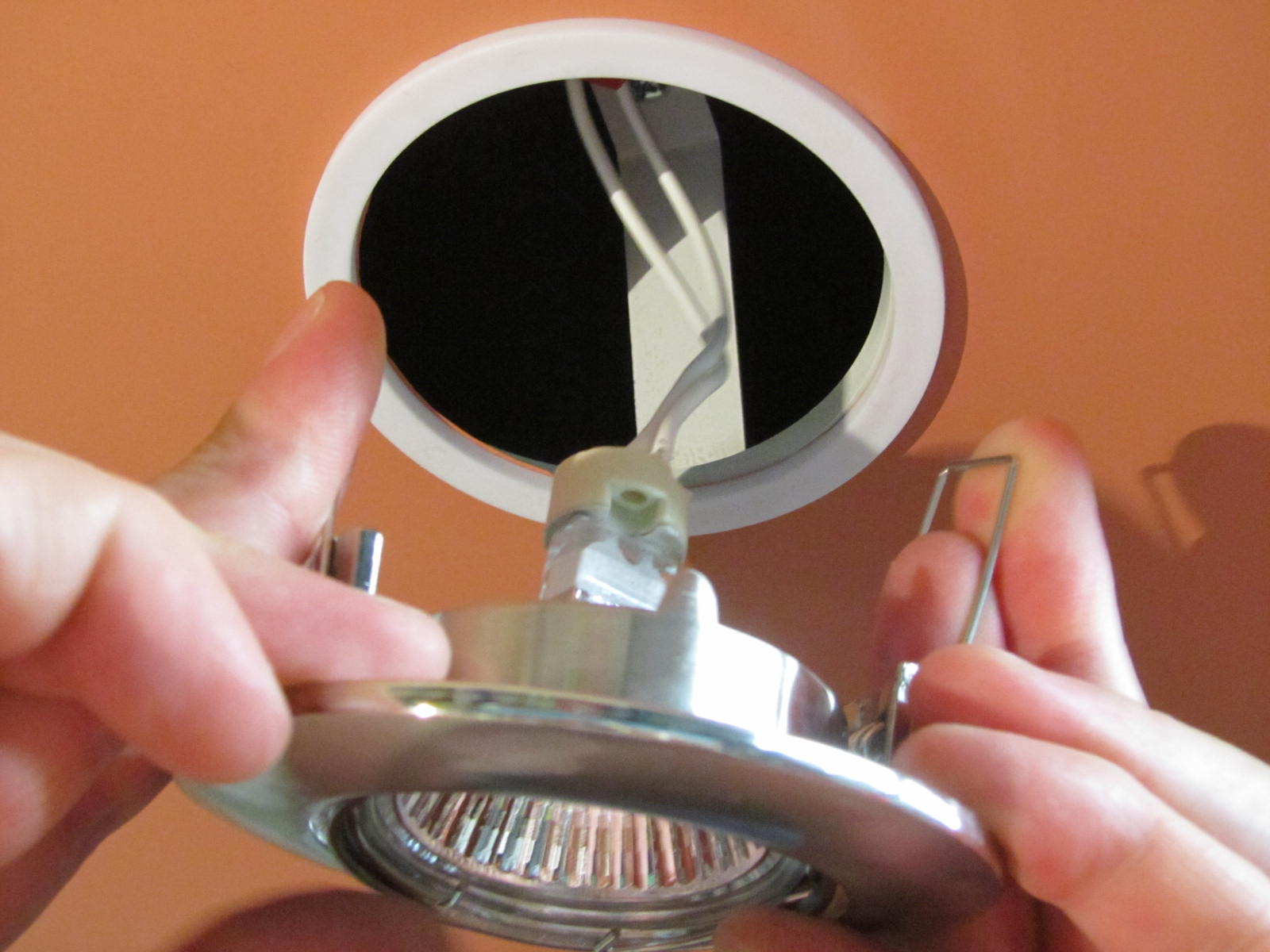
The harness was attached to the ceiling. It's time to connect the wires to the main wiring. To do this, the wires coming out of the wall were trimmed with a shift. Since the wire is quite old, the wires are rough. In order not to damage them, the insulation was removed thermally, namely with a soldering iron. The cores were protected, tinned, then insulating tubes were put on.
![]()
Tubes are needed in order to protect a person from a short circuit. The wires will not be able to touch one another on their own.
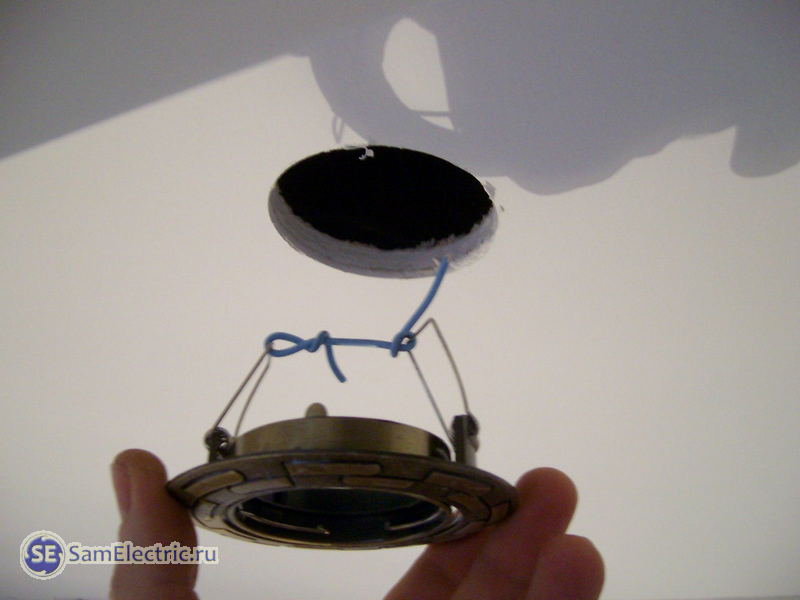
The place where the connection was made is fastened with a clamp to the ceiling using a self-tapping screw. Everything, wiring is completed.
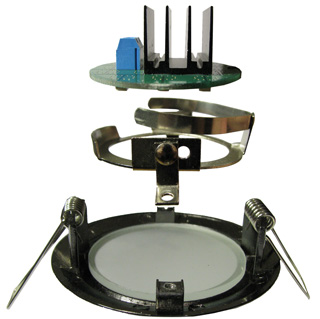
Temporary sockets are connected by terminal blocks, lamps are screwed in, it is possible to make repairs to the room.
Installation of a ceiling LED lamp on a PVC stretch ceiling
The technology described above is suitable for installing fixtures on a rigid structure, such as drywall or a slatted ceiling. If the luminaire is installed directly on the PVC ceiling, it is necessary to provide attachment points for the luminaires, otherwise the ceiling will sag under their weight.
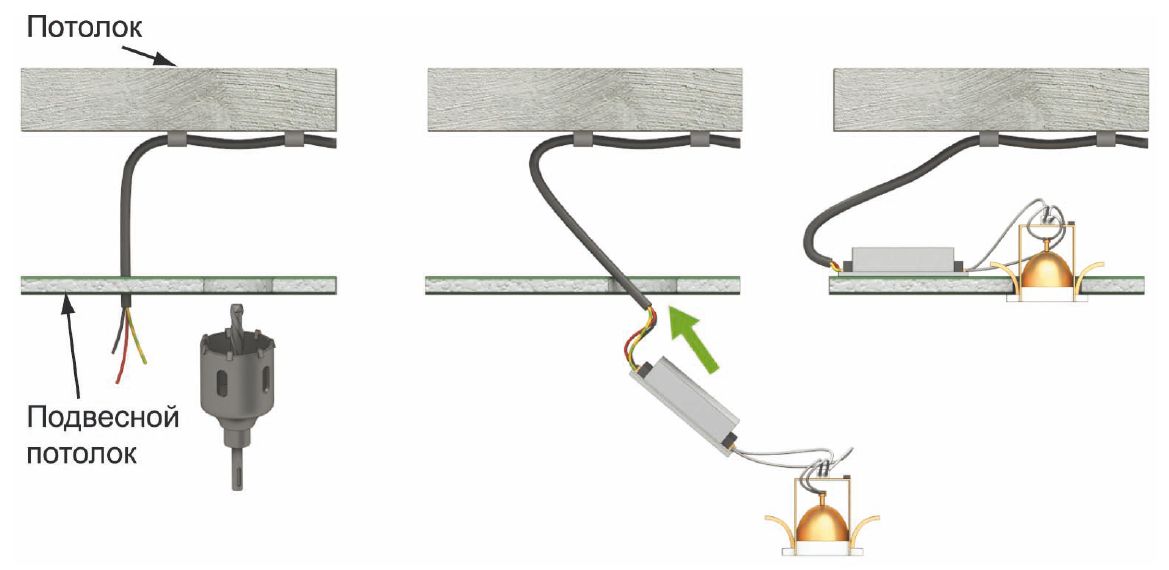
For such purposes, special fittings are sold on the market. In the photo you can see the ramp, that is, the mount for the lamp. The platform is made in the form of a cone, on the surface of which there are steps.
